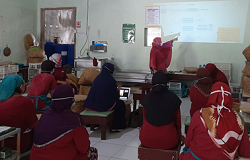Pemberdayaan Karyawati Pabrik Tempe Membuat Pupuk dari Limbah Cair untuk Budidaya Sayur Sehat
Empowering Tempe Factory Employees to Make Fertilizer from Liquid Waste for Healthy Vegetable Cultivation
DOI:
https://doi.org/10.33084/pengabdianmu.v7iSpecial-1.2961Keywords:
Vegetables cultivation, Tempe waste, Liquid organic fertilizerAbstract
The production of tempe by AULIA has created a new problem of smelly liquid waste. This problem may be overcome by converting the waste to organic liquid fertilizer for healthy vegetable cultivation. In this project, the women employee of AULIA tempe producer were trained in a program to utilize tempe liquid waste for healthy vegetable cultivation. The objective of this project was to improve their awareness of the environmental problem and convert such waste for healthy vegetable production. The activities during the training included counseling, training, and assistance in the production of activators, healthy vegetable cultivation by utilizing organic liquid fertilizer made of tempe liquid waste. The training was evaluated by conducting pre-and post-test to view the trainee's capability in absorbing the training program. Following the training, the trainee demonstrated their ability to absorb the training program as evidenced by their improved knowledge of the use of liquid organic waste (POC) by 34.4% and enhanced skill of organic liquid fertilizer and healthy vegetable cultivation by 66.7%. The result of the training program was the production of an organic liquid fertilizer marked as POCUMY. It was also found that POCUMY increased the show's healthy appearance of collards, chili, tomato, and eggplant. The training program conducted in this project has undoubtedly improved the trainee's skill in producing organic liquid waste and its use as a fertilizer for vegetable cultivation for family consumption.
Downloads
References
Athaillah, T., Bagio, Yusrizal, Handayani, S. 2020. Pembuatan POC Limbah Sayur untuk Produksi Padi di Desa Lapang Kecamatan Johan Pahlawan Kabupaten Aceh Barat. JPKMI (Jurnal Pengabdian Kepada Masyarakat Indonesia). 1(4):214-219. https://doi.org/10.36596/jpkmi.v1i4.103
Falahudin, I. 2014. Pemanfaatan media dalam pembelajaran. JLW (Jurnal Lingkar Widyaiswara) (Widyaiswara Network Journal): Peer-Reviewed Journal. 1(4):104-117
Kementerian Pertanian Republik Indonesia. 2011. Peraturan Menteri Pertanian RI tentang Pupuk Organik, Pupuk Hayati, dan Pembenah Tanah. Jakarta: Kementerian Pertanian Republik Indonesia. Jakarta
Kusumaningtyas, R.D., Erfan, M.S., Hartanto, D. 2015. Pembuatan Pupuk Organik Cair (POC) dari Limbah Industri Bioetanol (Vinasse) Melalui Proses Fermentasi Berbantuan Promoting Microbes. In Prosiding Seminar Nasional Kimia dan Pendidikan Kimia 2015. 1(6):82-87
Lestari, W., Lubis, J. 2019. Pemanfaatan Urin Sapi Dan Molase Menjadi Pupuk Organik Cair Di Desa Janji. Ika Bina En Pabolo: Pengabdian Kepada Masyarakat. 1(1): 1-9
Resty, Y. 2020. Cara Membuat EM4 Sendiri Mudah & Praktis. https://sinauternak.com/cara-membuat-em4/
Rineksane, I.A.R., Prabasari, I. 2020. Pemanfaatan Lahan Sempit Melalui Budidaya Sayuran Di Dukuh Tangkilan Sleman. Prosiding Seminar Nasional Program Pengabdian Masyarakat. 3(6):1290-1295. https://doi.org/10.18196/ppm.36.318
Salamah, Z. 2016. Pemanfaatan Mikroorganisme Lokal (MOL) Maja Untuk Meningkatkan Kualitas Pertumbuhan Tanaman Sawi CV. Tosakan. In Prosiding Symbion (Symposium on Biology Education). Yogyakarta: Universitas Ahmad Dahlan. 695-710
Sanjaya, I.G.M. 2016. Biokonversi Sampah Organik Pasar Menjadi Biogas Menggunakan Starter Effective Microorganisms (EM4). Sains dan Matematika. 1(1):17-19
Sayow, F, Polii, B.V.J., Tilaar, W., Augustine, K.D. 2020. Analisis Kandungan Limbah Industri Tahu Dan Tempe Rahayu Di Kelurahan Uner Kecamatan Kawangkoan Kabupaten Minahasa. Agri-Sosioekonomi. 16(2):245-252. https://doi.org/10.35791/agrsosek.16.2.2020.28758
Siboro, E.S., Surya, E., Herlina, N. 2013. Pembuatan pupuk cair dan biogas dari campuran limbah sayuran. Jurnal Teknik Kimia USU. 2(3):40-43. https://doi.org/10.32734/jtk.v2i3.1448
Supinah, P., Setiawan, W.F., Mulya, S.P. 2020. Sosialisasi Pemanfaatan Limbah Tempe Sebagai Pupuk Organik Cair untuk Pengelolaan Berkelanjutan di Desa Kuripan Kertoharjo. Jurnal Pusat Inovasi Masyarakat. 2(4):642‒646
Yusup, M., Suhandi, A. 2016. Pengaruh penerapan pembelajaran berbasis pengalaman menggunakan percobaan secara inkuiri terhadap peningkatan keterampilan proses sains siswa sekolah dasar pada pembelajaran IPA. EduHumaniora : Jurnal Pendidikan Dasar. 8(2):211-216. https://doi.org/10.17509/eh.v8i2.5144

Downloads
Published
How to Cite
Issue
Section
License
Authors who publish with this journal agree to the following terms:
- Any article on the copyright is retained by the author(s).
- Author grant the journal, right of first publication with the work simultaneously licensed under a Creative Commons Attribution License that allows others to share work with acknowledgment of the work authors and initial publications in this journal.
- Authors are able to enter into a separate, additional contractual arrangements for non-exclusive distribution of published articles of work (eg, post-institutional repository) or publish it in a book, with acknowledgment of its initial publication in this journal.
- Authors are permitted and encouraged to post their work online (e.g., in institutional repositories or on their websites) prior to and during the submission process, as can lead to productive exchanges, as well as earlier and greater citation of published work.
- The article and any associated published material is distributed under the Creative Commons Attribution-ShareAlike 4.0 International License










